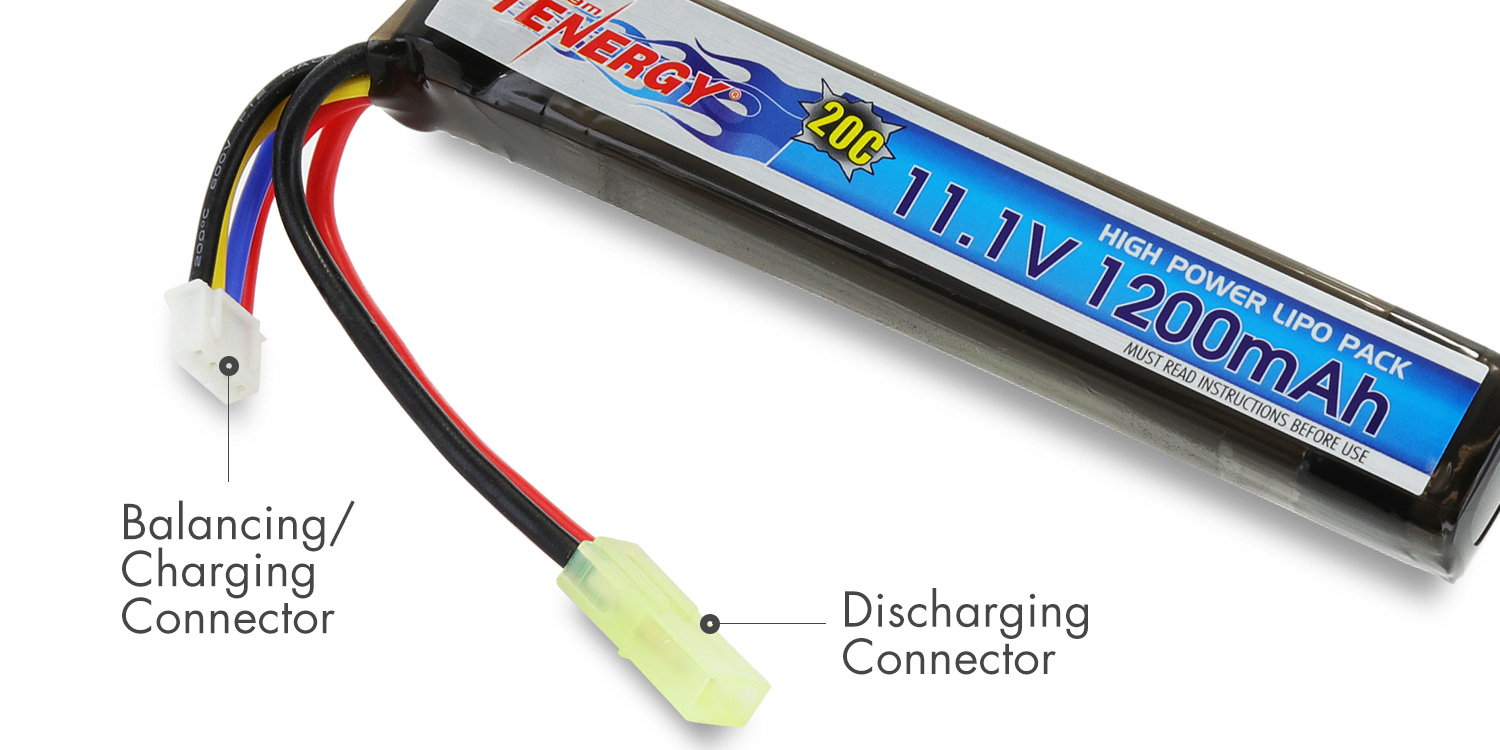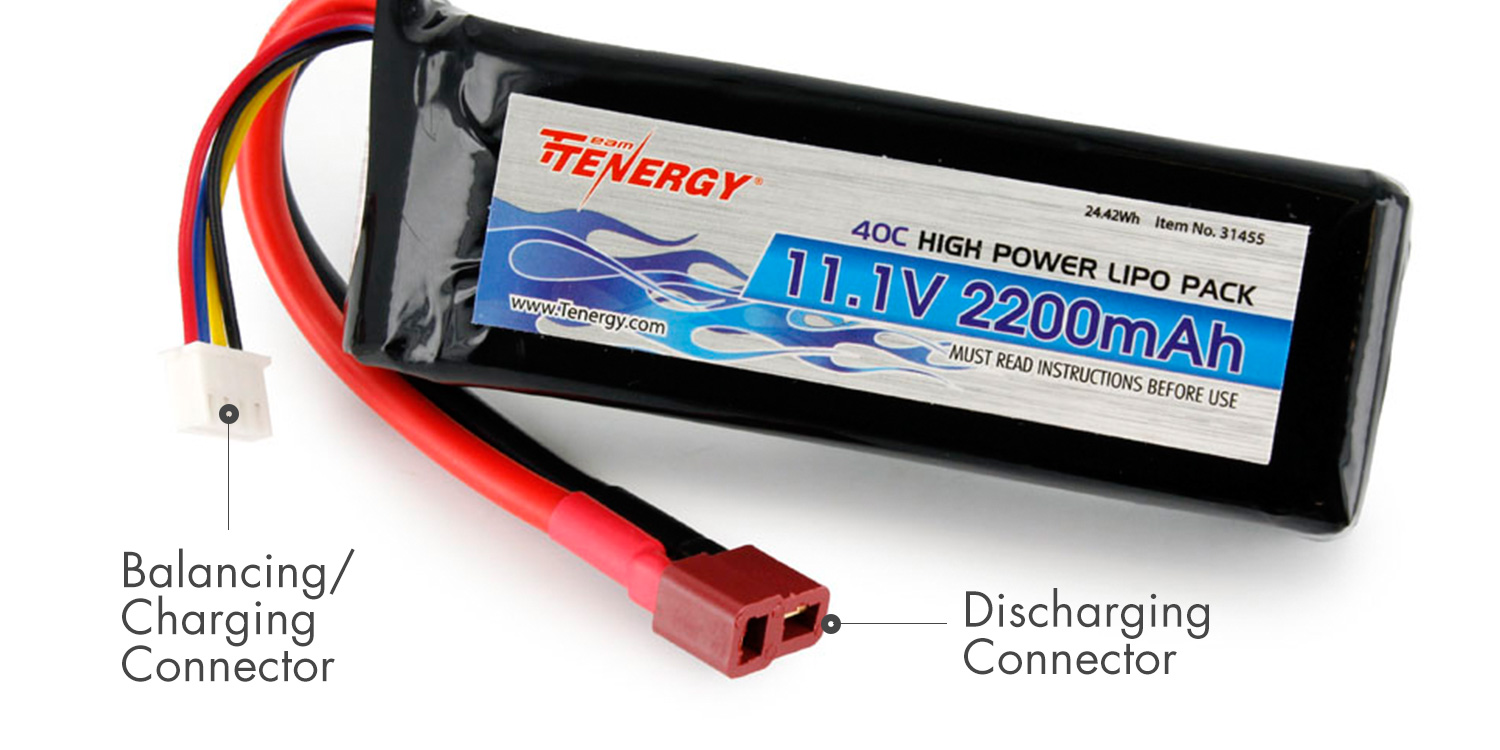|
|
IMPORTANT!!! READ MANUAL in its entirety before use. Take extra precautions when handling Lithium Polymer (LiPo) batteries, as they require different safety measures compared to NiMH or NiCd batteries! Failure to follow these instructions can result in severe permanent damage to battery, cause serious personal injury, or lead to a fire. |
LiPO batteries are intended to be used with compatible radio controlled (R/C) models and airsoft guns only. Any damage caused by misuse or modifications will void your warranty and can cause serious injury.
By purchasing this product the buyer/user agrees that they have read and understood the safety precautions printed in this document and accepts full responsibilities of these risks. By agreeing, the user/buyer does not hold Tenergy, its distributors, or its retailers responsible for any accidents, injury to persons, or property damage that may occur.
If buyer/user does not agree with these conditions, please return the battery in its original condition immediately to the place of purchase.
General Safety Guidelines
- NEVER use a NiCd/NiMH charger to charge LiPo batteries. Only use chargers designed for Lithium Polymer (LiPo) batteries.
- NEVER store LiPo batteries in any location that exceeds 40-80° F (e.g. in a car, garage, or in the sun)
- NEVER leave charging batteries unattended. Keep watch on the charging process & react to any potential problems that may occur.
- NEVER let the battery’s positive and negative leads to touch. This can cause the battery to short and lead to a FIRE. If for any reason you need to cut the terminal wires, it will be necessary to cut each wire SEPARATELY, to make sure the wires do NOT touch each other.
- NEVER charge a swollen or ballooned battery (even if swollen upon purchase). Continuing to charge a battery that has begun to swell will result in a fire. Follow these steps:
a. STOP the charging process and disconnect battery immediately
b. Disconnect battery from the device immediately.
c. Place it in an open non-flammable area.
d. Watch it for approx. 30 minutes from a safe distance.
e. Follow proper procedure to dispose of battery - ALWAYS inspect the battery to make sure there are no signs of damage, deformity, or swelling before charging. If there are, STOP charging the battery and follow the proper procedure to dispose of the battery.
- ALWAYS charge batteries in a fireproof container and away from combustible material. Do NOT charge on surfaces that can catch fire – this includes: wood, cloth, carpet, or in the application’s device.
- ALWAYS store LiPo batteries in cool, dry places between 40-80° F.
- If the battery reaches high temperatures in the event of an R/C Model crash, follow these steps:
a. Disconnect battery immediately from the device
b. Place it in an open non-flammable area.
c. Watch it for approx. 30 minutes from a safe distance.
d. If the battery appears to be stable (no signs of damage or swelling) proceed to put it back into your device and continue using with caution. - Keep LIPO batteries out of reach of children or pets.
Avoid Over-Discharging LiPo Batteries
Over-discharging—continuing to use a LiPO battery even when it is almost completely drained or below its minimum voltage level—can cause permanent damage to the battery.
The damage caused by this can be INTERNAL battery damage and will not always be visible. However, internal damage can eventually lead to a FIRE when attempting to re-charge it at later times.
*Caution: this problem can be easily and commonly overlooked in Airsoft applications because there are no indicators that the battery is at a low voltage and should be removed to be re-charged. Please exercise proper understanding and usage of the battery in your application to prevent safety issues or injuries and to prolong battery life.
|
Part #52023 |
Tenergy recommends using a low voltage detecting device for LiPo batteries in Airsoft guns. An example is the Tenergy LiPo Alarm (PN#52023). This LiPo alarm is a great preventive measure for maintenance and longevity of LiPo battery packs.
|
Charging Batteries
Caution – Before Charging
1) ALWAYS visually inspect LiPo battery for any damaged leads, connectors, shrink wrap, swelling of cells, or other irregularities before charging or using.
2) Do NOT use if you find any of the above issues with your pack.
3) Before installing or changing the connector, check the voltage of the pack using a digital voltmeter (not your charger).
All new packs ship at approximately 3.80V per cell.
• Examples:
i. 2S pack should read approximately 7.60V
ii. 3S pack should read approximately 11.40V
4) Do not attempt to charge any pack if open voltage per cell is less than 3.3V
• Examples
i. Do not charge a 2-cell pack if below 6.6V
ii. Do not charge a 3 cell pack if below 9.9V
If any damage to the pack or leads is found, or if the voltage is significantly less for your pack than specified above, do NOT attempt to charge or use the pack. Contact Tenergy directly as soon as possible.
Tenergy LiPo batteries have two separate leads. The shorter lead with the WHITE (JST XH) connector is for charging and cell-balancing. The second longer lead is for discharging or the power source for your R/C models or airsoft guns.
Examples:
 |
 |
Charging LiPo Batteries
- NEVER leave charging batteries unattended. Constantly watch the charging process and react to any potential problems that may occur.
- ONLY charge batteries in a fireproof location. NEVER charge on wooden surfaces, cloth, carpet, or materials that can catch fire.
- Allow the battery to cool down to ambient temperature before charging.
- Do NOT charge multiple battery packs in series. Charge each battery pack individually. Failure to do so may result in incorrect battery recognition and charging functions. Overcharging may occur and result in FIRE.
**In order to discharge packs in series, the charged voltage of both packs must be within 0.01V for the same cell count pack. - Use the JST XH connector for charging. There are two sets of lead wires on Tenergy LiPo batteries and the shorter lead is almost always used for charging.
Note*See picture above to identify JST XH cable for charging - When selecting the cell count or voltage for charging purposes, select the cell count and voltage as it appears on the LiPo battery label. Selecting a cell count or voltage other than the one printed on the label will cause improper charging rates that can lead to fire.
- As a safety precaution, confirm the information printed on the battery is correct.
• Example: The label on a 2-Cell battery pack in series will read – “7.4V” – You must select 2-Cell for charging.
• Example: The label on a 3-Cell battery pack in series will read – “11.1V” – You must select 3-Cell for charging. - You must check the pack voltage before charging. Do not attempt to charge any pack if open voltage per cell is less than 3.3V. For example:
• Do not charge a 2-cell pack if below 6.6V
• Do not charge a 3 cell pack if below 9.9V - In most cases the charger's charging current should not exceed 1C, unless otherwise noted. A higher setting may damage the battery & cause a fire.
C-rating is a standard which defines a battery's operating current based on its capacity. 1C is the current it takes to approximately fully discharge a battery in 1 hour, and is simply defined by dropping the "h" in the pack's capacity (e.g. 1C for a 1000mAh LiPo battery is 1000mA, or 1A). The examples below demonstrate how to figure out the proper charging current for different packs:
i. 900 mAh LiPo Batteries -> Charge at or below 900 mA
ii. 1300 mAh LiPo Batteries -> Charge at or below 1300 mA, or 1.3 A
iii.2200 mAh LiPo Batteries -> Charge at or below 2200 mA, or 2.2 A
Additional Notes:
Some LiPo chargers on the market may contain insufficient or incorrect information regarding the battery packs they are designed for. It is the user’s responsibility to assure the charger you purchased is compatible with Tenergy's batteries.
Discharging Batteries & First Uses
Battery packs should NEVER be over-discharged at any time.
Specifically, over-discharging on the first use will ruin the battery permanently before you get to fully enjoy it.
Be extremely careful not to over-discharge new packs:
- We recommend 3-5C max average discharge for breaking in new packs.
Batteries Involved In Crashes/Severe Impact
For RC car or plane devices, carefully inspect your battery after any severe crash. Cautiously look for any damaged leads, connectors, broken shrink-wrap, punctures, swelling of cells, or other irregularities.
Not doing so can lead to battery failure at some point in the future or even possible fire.
In the event of a crash or if the battery exceeds high temperatures:
- Disconnect battery immediately from the device.
- Place it in an open, non-flammable area.
- Watch it for approx. 30 minutes from a safe distance.
- If the battery appears to be stable (e.g. no signs of damage or swelling), proceed to put it back into your device and continue using with caution.
For Airsoft applications, while the battery may not be susceptible to a crash, please be aware of severe direct impact. Exercise caution and follow the procedure above if you feel the battery's safety has been compromised.
Battery Maintenance & Handling
- NEVER disassemble existing LiPo packs to mix with other LiPo cells/packs.
- Use a high quality Lithium Polymer charger – a poor quality charger can be dangerous.
- Do NOT discharge battery to a level below 3V per cell under load. Deep discharge below 3V per cell can deteriorate battery performance. Be sure to set your ESC for the proper cut off voltage (6.0V cut off for 2S packs, 9.0V cut off for 3S packs, etc).
- For Airsoft users, use extreme caution and protect LiPo batteries to avoid puncture of the cell – punctured cells can cause fire.
- For Airsoft users, it is recommended to use a Low Voltage Detection Device to warn users when the battery pack voltage is too low. This ensures longer battery life & prevents dead batteries.
Operating Temperatures:
- Charge: 32 to 113°F
- Discharge: 32 to 140°F
- Let battery cool down to ambient temperature before charging.
- During discharge and handling of batteries, do not exceed 160°F.
Storage & Transportation
- NEVER store batteries near an open flame or heater.
- Do NOT expose battery pack to direct sunlight (heat) for extended periods of time
- Storing battery at temperature greater than 170°F for extended periods of time (more than 2 hours) can cause damage to battery and a possible fire.
- For long term storage, do NOT store batteries fully charged; it is recommended to fully charge and then discharge it to 50-60% of their capacity before storing.
- Store battery at room temperature between 40 and 80°F for best results.
- When transporting or temporarily storing in a vehicle, temperature range should be greater than 20 °F but no more than 150°F.
Battery Life & Disposal of LiPo Batteries
Rechargeable LiPo batteries do NOT last forever. Batteries that have lost 20% of their initial capacity should be removed from service and disposed of properly.
If at any time you see any physical damage in a LiPo battery such as swollen cell, split, or tear in the cell’s foil covering, STOP usage immediately and dispose of battery at a local recycling location.
Proper Disposal Procedure of LiPo Batteries:
Battery disposal guidance varies based on your location. We recommend finding a local recycling location using the locator on Call2recycle.org. For any additional questions, contact your local recycling center for more specific disposal information.
Product Warranty
Product warranty is limited to original defects in material and workmanship. Warranty does not cover collateral damage. Due to the nature and use of this product, there is no term warranty. Misuse, abuse, incorrect charging, failure to comply with the above warnings and guidelines, and other inappropriate use of this product will not be covered under warranty.
1) NEVER leave charging batteries unattended. Constantly watch the charging process and react to any potential problems that may occur.
2) ONLY charge batteries in a fireproof location. NEVER charge on wooden surfaces, cloth, carpet, or materials that can catch fire.
3) Allow the battery to cool down to ambient temperature before charging.
4) Do NOT charge multiple battery packs in series. Charge each battery pack individually. Failure to do so may result in incorrect battery recognition and charging functions. Overcharging may occur and result in FIRE.
**In order to discharge packs in series, the charged voltage of both packs must be within 0.01V for the same cell count pack.
5) Use the JST XH connector for charging. There are two sets of lead wires on Tenergy LiPo batteries and the shorter lead is almost always used for charging.
Note*See picture above to identify JST XH cable for charging
6) When selecting the cell count or voltage for charging purposes, select the cell count and voltage as it appears on the LiPo battery label. Selecting a cell count or voltage other than the one printed on the label will cause improper charging rates that can lead to fire.
7) As a safety precaution, confirm the information printed on the battery is correct.
· Example: The label on a 2-Cell battery pack in series will read – “7.4V” – You must select 2-Cell for charging.
· Example: The label on a 3-Cell battery pack in series will read – “11.1V” – You must select 3-Cell for charging.
8) You must check the pack voltage before charging. Do not attempt to charge any pack if open voltage per cell is less than 3.3V. For example:
· Do not charge a 2-cell pack if below 6.6V
· Do not charge a 3 cell pack if below 9.9V
9) In most cases the charger's charging current should not exceed 1C, unless otherwise noted. A higher setting may damage the battery & cause a fire.
C-rating is a standard which defines a battery's operating current based on its capacity. 1C is the current it takes to approximately fully discharge a battery in 1 hour, and is simply defined by dropping the "h" in the pack's capacity (e.g. 1C for a 1000mAh LiPo battery is 1000mA, or 1A). The examples below demonstrate how to figure out the proper charging current for different packs:
i. 900 mAh LiPo Batteries -> Charge at or below 900 mA
ii. 1300 mAh LiPo Batteries -> Charge at or below 1300 mA, or 1.3 A
iii. 2200 mAh LiPo Batteries -> Charge at or below 2200 mA, or 2.2 A








